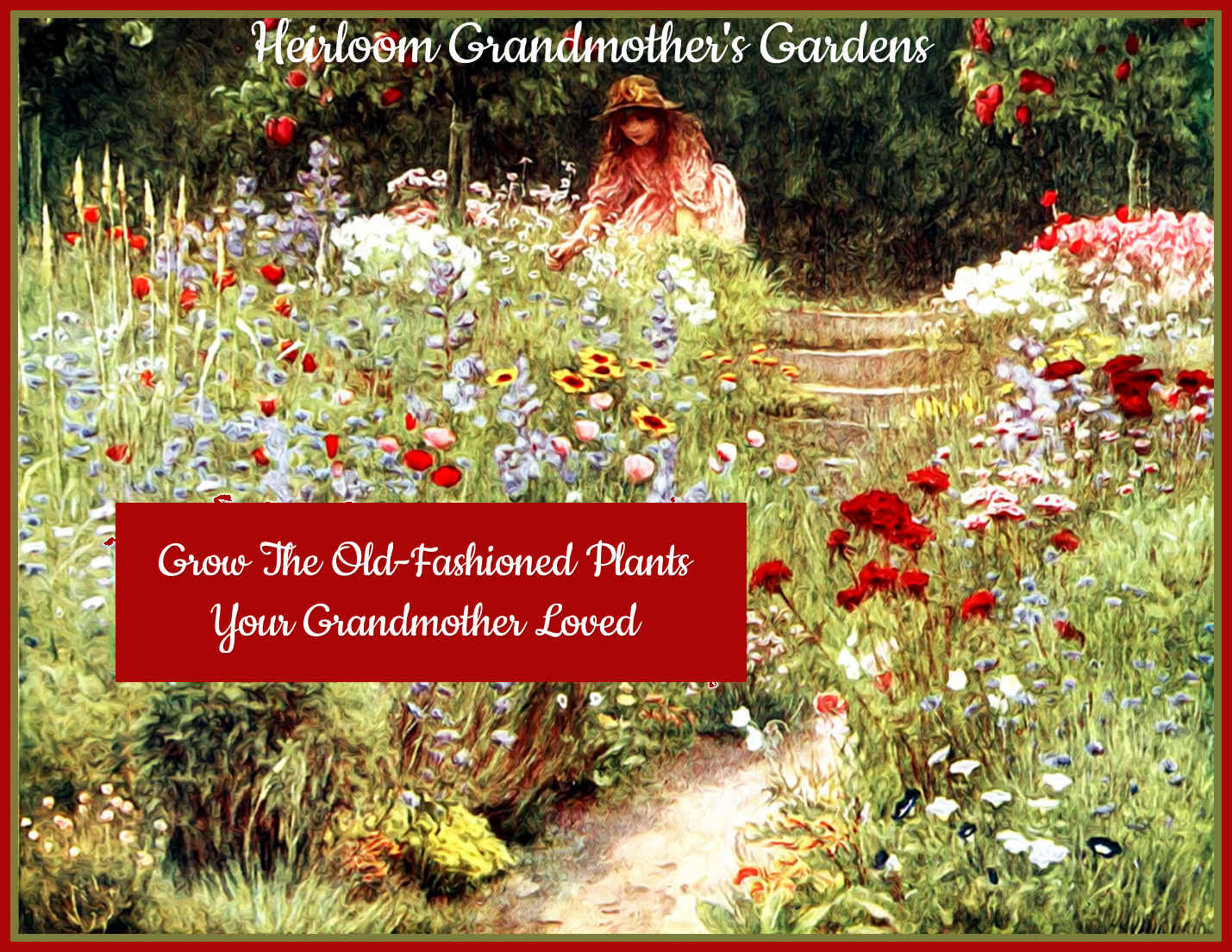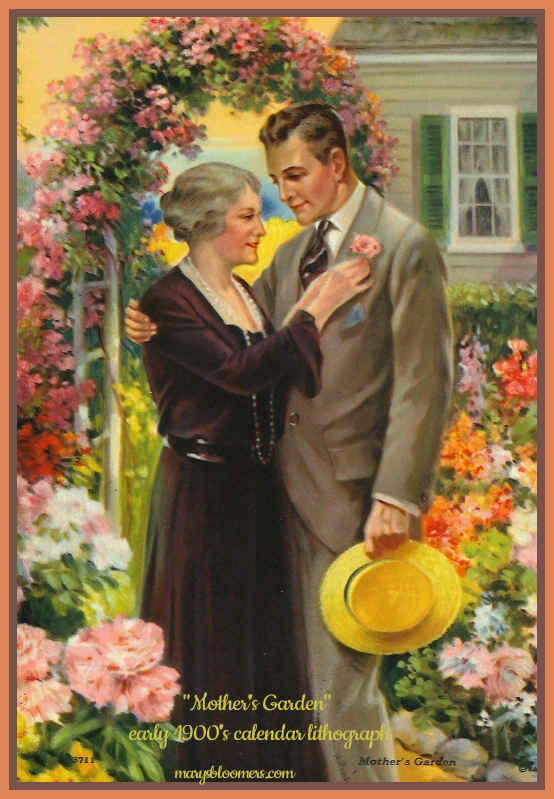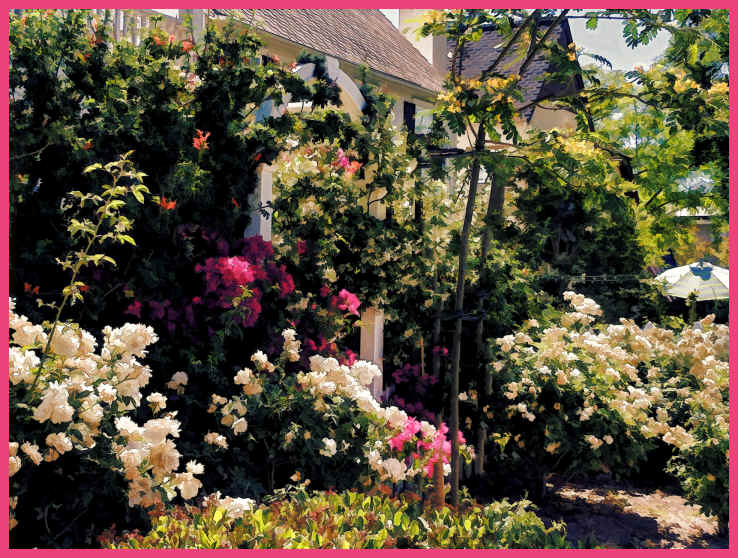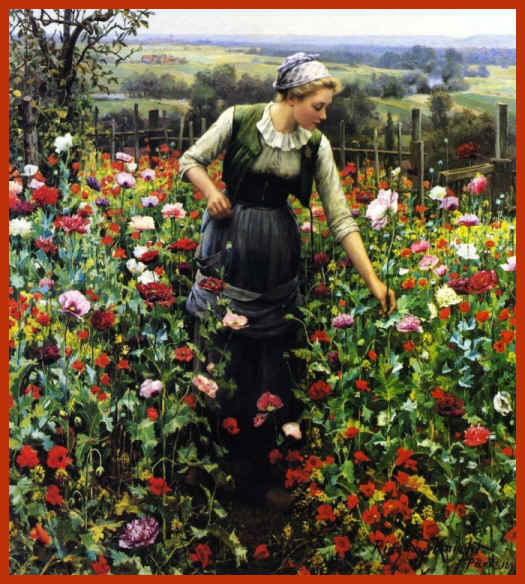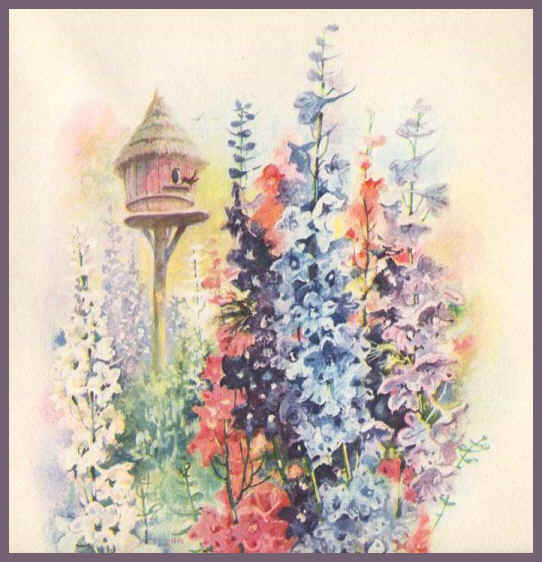|
Heirloom
Pass-Along Plants and Seeds For A "Grandmother's
Garden" Theme
Recreate the Grandmother's Garden, and pass along Grandma's
tried-and-true heirloom plants to future generations. When you pass along a
plant, share cuttings, or keep seeds from year to year, you're connecting to
ancestors, family, friends, and neighbors. Old-fashioned plants were an essential part of grandmother’s
gardens, too.
Gardeners turned
away from the brightly-colored and exotic annuals of the Victorian era, and grew
flowers that had a long history in gardens, especially perennials like peonies and iris, self-sowing annuals such as larkspur and poppies, and bulbs
that would return and multiply year after year, like daffodils and snowdrops.
Visit
this page for a listing of flowers and their sentimental
meanings.
Pretty and old-fashioned Grandmother’s Gardens
‘My grandmother grew that
flower in her garden.’
Grandmother’s old-fashioned garden is as appropriate today as it was a
hundred years ago. And the style has charm around any home - modern or vintage.
Grandmother recognized those plants that could flower with little cost, and add
fragrance, color and grace to our gardens. If you have plants passed down
by our own grandmothers, all the better.
“Grandmother’s gardens” were the informal, mixed-flower
gardens that became popular in the late 1800's, as a rebellion against formal Victorian carpet
bedding flowers. Old-fashioned plants were an essential part of grandmother’s
gardens, too. Gardeners turned away from the brightly-colored exotic annuals of
the Victorian era in favor of flowers that had a long history in gardens,
especially perennials like peonies and iris, self-sowing annuals such as
larkspur and poppies, and bulbs that would return and multiply year after year,
like daffodils, hosta and snowdrops.
Heirlooms are once again highly valued. They
were brought
back for their hardiness, adaptability,
reliability and pest and disease resistance. The daylilies,
hollyhocks and four o’clocks found in your grandmothers’ gardens needed very
little care and always looked and smelled wonderful. A new generation of
gardeners is learning how to grow and tend to these gardens. Most plants were
grown from seed. You can find collections of heirloom seeds from seed banks and
specialty catalogs.
The heirloom gardens differed from gardens
found overseas, like English gardens, because they were most often the work of one person, usually a woman, instead of a
team of gardeners. Appearing haphazard or growing at random, these gardens actually were
designed much like paintings, with an eye for composition using color, shape and
texture.
Grandmother’s Gardens are the offshoots of American cottage gardens,
which contain a diversity of plants, including vegetables and flowers for
cutting. Recreating them means designing landscapes
overflowing with hardy perennials, annuals
and Native American plants. And with their abundance of
old-fashioned flowers, Grandmother’s Gardens are not the easiest gardens to
manage and keep in-bounds. It takes thought to plant the right combinations of historic flowers,
and an effort to start at least some heirloom plants from seed, which is
time-consuming and not for the impatient gardener. It's perfectly fine and easy
to find seedlings and plants of heirloom varieties, and that makes
planning and maintaining your garden easier.
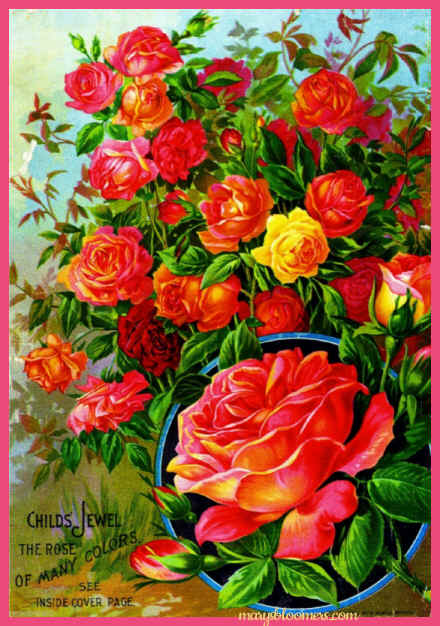 |
Those Incredible Heirloom Roses
Heirloom roses to consider include the species and early hybrids
developed before 1867.
Most heirloom roses bloom only once in the late spring and
early summer, but stay in bloom for up to three weeks.
In those three weeks, they
will produce more and better blooms than modern hybrids do all summer long.
Most also have
a strong and beautiful scent that many modern hybrids lack, and they require little, if any,
care.
Climbers, drift roses, fluffy
cabbage roses, ramblers, and petite groundcover roses have never lost their
appeal. They're just a little harder to find.
|
Pass-along plants don’t have to be inherited or bought.
They’re often
swapped or given as gifts among gardeners and their friends.
Besides the nostalgic value, heirlooms fit with trends of
sustainability and local sourcing. And, some of them are so unique in
appearance, they'll have visitors amazed when they see them. There is a certain
wow factor attached to what seems to be under-utilized garden oddities, and they
make valuable additions to any style of garden design. Many new gardeners will
grow heirloom
vegetables because of the taste and variety.
Some of the pass-alongs, like cone-flowers
(Echinacea) and bee balm (monarda), are important in pollinator-friendly landscapes, wildflower meadows and
prairie-style gardens. Heirloom perennials, like columbines, iris, peonies,
lavender, poppies, daffodils, tulips and crocus; and annuals like zinnias,
dahlias, calendula, hyacinth bean and nigella, can add a nostalgic touch to modern
landscapes.
Growing heirloom vegetables is becoming increasingly popular,
and can provide us with gastronomical glimpses into our agricultural heritage.
Plants had strange-sounding names like Rat-tailed radish, dragon-tongue carrot, bloody butcher corn and rattlesnake
bean. And then there are sentimental varieties, like Aunt Molly's ground
cherry or Aunt Ruby's German green tomato. Heirloom flowers, like love-in-a-mist and kiss-me-over-the-garden-gate, bring romance to the garden.
Often called "heirloom seeds," the old varieties
number in the thousands, making it difficult to choose a favorite. Heirlooms
grow true from seed. That means if you gather up the seeds from this year’s
tomatoes to plant next year, next year you’ll get very similar tomatoes.
That’s not true of more modern hybrid tomatoes.
Many of the
hybrids offered today are designed to be better suited for survival, offer a
more consistent yield, and can be grown in a wider range of climates. But the
recent increase in growing heirloom fruits and vegetables has caused many seed
catalogs to carry these seeds, devoting entire sections to them. Nursery and seed catalogs often included collections of plants
for those who had lost the plants of grandmothers’ gardens. Heirlooms
are also available at garden centers and in catalogs. Burpee, Johnny’s Selected Seeds
and Seed Savers Exchange are among heirloom seeds and plant sources. While heirlooms are tough, some are
susceptible to diseases that hybrids resist. For example, modern tomatoes
usually have some initials after their name indicating resistance to
verticillium, fusarium and other common blights.
What Makes An Heirloom Plant?
In order for plants to be considered heirlooms they must have
three characteristics.
First of all, almost all heirlooms are open-pollinated varieties. Most
of the seeds sold today are hybrids and seeds from these plants will usually
take on the characteristics of just one of their genetic parents. Heirlooms will
grow “true to type” from their seeds. This means seed-savers like Grandma
can enjoy the identical variety year after year.
You should be able to trace heirloom varieties back fifty years
or longer. Many of the heirloom
vegetables available can be traced back even farther. Pre World War II seed
catalogs are filled with today’s ‘heirlooms’. Commercial seed companies
dropped most of these for the more durable hybrid counterparts. But, these
heirlooms have been rediscovered and are beginning to become available again
today. The fifty-year cut-off predates the most popular hybrids, and many of
these early varieties are lost. But this makes today’s true heirlooms that
much more valuable.
The final determining characteristic of heirloom vegetables is
their histories. Many of these varieties were collected and saved by families
and ethnic groups dating back to their European or South American counterparts.
Seeds were gathered and saved, for the following season’s crop. This practice
protected the genetic make–up
that made the specific plant successful within each particular environment.
These base characteristics have become invaluable and the
genetic strains of these vegetable forefathers are the backbone to today’s
disease and drought-resistant hybrids. Professional seed houses collect and
store these to preserve these characteristics to combat future unseen
agricultural catastrophes.
Edible Crop Favorites
There is a common myth that the
heirlooms won’t be as resistant to pests and disease
as their hybrid counterparts, but the fact is, heirlooms can handle conditions just as
well, if not better, than comparable hybrids.
Egyptian Walking Onion
Most onions have to be harvested and replanted every year, but this
one is a true bulb that gets 4-5 feet tall, almost up to your chest. It’s
more like a flower.
It creates a cluster of bulbs on the top, which are the plant’s
seeds, and then it falls over and roots in. It’ll literally walk around your
garden. You'll obviously need room for that, or cut off the bulbs on the top.
Tomatoes:
German Pink
It's
called a "potato-leaf" type because the foliage resembles the leaves
on potato plants. It produces 1- to 2-pound, meaty, full-flavored fruits.
Excellent for sauces and slicing. Grandmothers served their grandchildren slices on a
white platter, sprinkled with sugar.
Mr. Stripey
Reddish-yellow with vertical yellow and red stripes.
Cherokee Purple
Dark purple-red, almost black fruit.
Black Krim
Some of the most beautiful tomatoes you'll ever see. They’re deep
maroon, and the flavor is rich
Mortgage Lifter
A plant breeder named M.C. Byles cross-bred his way into this tomato variety in the 1930s, and by the 1940s, he had sold so many plants that he paid
off his $6,000 mortgage. The plants grow tomatoes between one and three
pounds, and the pink-red fruit is super-tasty without many seeds.
Brandywine
Brandywines are among the most popular
heirlooms, and they come in yellow, red, pink, and purple varieties They’re
classic and full-flavored with just the right amount of acid. I don't think
Brandywines ever fell out of favor.
Green Zebra
Approximately the size of a baseball. Lots of spicy, tart flavor.
Boxcar Willie
These tomatoes produce prolifically over a
long season. They’re rounder than some of the other varieties, which
makes them great for sammiches and to top your burgers..
Lettuce
Grandpa Admire's
George Admire was a civil war veteran born in 1822. Bronze-tinged
leaves form loose heads. It stays crisp and sweet — even in extremely hot
temperatures. It is slow to bolt and go to seed.
Beans
Purple-Podded Beans
This heirloom pole bean was discovered by Henry Fields (of the famous seed
company) in an Ozark garden in the 1930s. Plants climb vigorously to 6 feet and
are productive, flavorful and meaty. The 5-7" pods turn green when blanched
in boiling water.
Melons
Moon and Stars
We thought this legendary melon was long-lost, but it was rediscovered by Seed
Savers Exchange. The dark green oval
melons are covered with pea-sized bright yellow "stars" and usually
one larger "moon." The leaves also have the same design. The sweet
pink flesh is excellent. Matures in 90-95 days and is well worth the long wait..
Dill
Grandma Einck's
The fragrant heads are large with plump seeds, perfect for dill pickles,
summer salads or a beautiful filler for summer flower bouquets.
Grandma
Knew How to Grow Prize-Winning Heirloom Tomatoes
Nothing seems to astonish a gardener more than the abundance, the size and
taste of an Heirloom Tomato.
Grandma chose her heirloom tomatoes for
color, shape,
taste, and size
Having a wide variety of colors, shapes, and sizes allows for gorgeous
salads, preserves, and displays for the fair. There are lots of red beefsteak-type tomatoes to choose from and this is what most people grow. Other varieties
have a different mix of acidity and sweetness for the ultimate test of a
homegrown tomato – that amazing taste
Grandma started her seedlings indoors
Plant just three seeds per pot. You’re going to destroy the weakest
of these seedlings. So there’s no need to plant more. If your seed
has good germination all three seedlings will sprout. After these have
their first true leaves, pinch out the two weakest seedlings from each pot.
This will leave you one strong seedling to continue growing.
Use cinnamon to protect against damping-off and other fungal diseases. Sprinkle cinnamon on the soil when you first plant the seed. Water the pot
from the bottom only. Reapply cinnamon after watering or if you see any
white mold beginning to form on the surface of the potting soil.
Place your seed pots on the radiator (the old-fashioned
heavy iron thing monstrosity that heated
your rooms with steam). The heat will help germinate your seeds and grow your plants.
Tomatoes love heat.
Grandma prepared the best spot in her garden to plant her tomatoes
Before you plant the seedlings out in the garden, after the soil has warmed
up and all danger of frost has passed, prepare the soil. Tomatoes need
loose, fluffy soil and full sun.
When transplanting, plant the tomato plant a
few inches lower than it was originally.
It will form a stronger root system. Every inch of stem below the soil
surface will produce roots, anchoring the vine. I like to plant mine with about
half the height of it's stems underground to make them sturdy, shorter and bushier.
Grandma gave her blue ribbon heirloom tomatoes the best care
Provide consistent watering, at least an inch of water a week. Check the
plants weekly for tomato hornworm, whitefly, mites, or flea beetle infestations.
Inconsistent water can cause the tomatoes to split before they are ripe.
Cherry tomatoes are especially susceptible. Mulching the soil surface,
even on container-grown plants, can help.
How Grandma grew the largest tomatoes
Winning blue ribbons at the fair for her
astounding tomatoes meant a lot to her.
She set a few tomato plants aside for
her extra-special treatment:
For the largest tomatoes, train these special tomato plants to
only one main stem.
Remove all suckers, so that the plant puts its energy
into a strong support structure.
Easier said than done.... Allow only 3 to 5 tomatoes to develop per plant. I
have never been able to do that - I want every tomato I can get.
Remove the immature fruit
from the top of the vine.
Keep the fruit that is closest to the main stem.
If you follow these directions, the plant sets fruit and it won’t have to work as hard to grow
big and heavy winners.
Grandmother's
Best-Loved Ornamental Plants
Plants were important, but equally significant were the gardens’
designs and uses. In an article in Better Homes and Gardens,
“Quaint Beauty in Old-Time Gardens,” published in 1929, the writer said that
“the old-time garden meant, first of all, privacy and seclusion and restful
quiet: a place where one might enter in, shut the gate, and forget the world
outside.”
She recommended a hollyhock lane or aisle of roses to border the walks.
There should be sheltered seats and quiet nooks. It was a “place for the
children to play, with secluded nooks in which elders might read and lovers
might hide; a retreat for birds to nest and sing in, free from the ravages of
wayfaring cats.” Picket fences, brick walls, and hedges might enclose it; bird
baths and sun-dials might add to its beauty. All was to be assembled in a casual
way, encouraging enjoyment, not admiration.
There were probably boxwood shrubs on either
side of the front steps. If not boxwoods, then some kind of evergreen shrub,
giving off a musty faint odor. Next to these were probably yellow bell
(forsythia) bushes. At a special place of honor was usually a special rose bush,
Grandma's pride and joy. It usually had a story attached to its origin.
Sometimes it was a cutting started from a dear friend's bush, or had been
carried a great distance to rest in that soil.
The back door, usually off the kitchen,
sometimes had hollyhocks or sunflowers planted there. There was an old saying
that if you planted a sunflower at your kitchen door and watered it everyday,
you would be granted one wish. As for the hollyhocks, many little girls have
made fancy dress lady dolls out of their blooms.
Every gardening grandmother worth her salt had
planted both marigolds and zinnias. Many had "dinner plate" dahlias. Grandma was also
quite partial to four o'clocks,
snap dragons, sweet peas, petunias, nasturtiums and of course, roses.
A lot of the flowers were grown from bulbs
and tubers carefully separated and replanted each year and shared with friends.
These included daffodils, lily of the valley (in fact lilies of many different
varieties), irises and "glads". Several old-fashioned flowers are
perennials and die down to the ground, but come back year after year. Bleeding hearts,
Lily of the Valley and Peonies are just a few. I love the sweet and heady
fragrance, but I'm not so in love with the petals that fall from the Peony
flowers placed in a vase that land on my furniture. Cut peonies require my
digging up a pretty white or pink doily to place under the vase, so that the
petal drop isn't so noticeable, and it won't hurt my tables. It gives me a
reason to admire my vintage linens.
In every old-fashioned yard, there were flowering
shrubs. Forsythia, of course, but there was also bridal veil spirea, snowball bushes, mock orange, and of course, lilacs.
It was believed that lilacs wouldn't bloom until seven years after planting. One
particular shrub, the "sweet bubbie" seemed to be planted most often
near a bedroom window, so that on warm summer nights when the windows were open, the spicy-sweet smell of the little
blooms would drift through the house. Today, we don't often open our
windows in summer because we have air-conditioning. We sit in the garden
or bring cut flowers indoors to fill vases.
Many old-fashioned flowers are
recognizable as scents in today's perfumes, and they invariably bring
Grandma to mind. Like lavender and Lily of The Valley, Lilac and
Verbena. Many of the old articles in seed catalogs used lovely common names for
flowers, “pretty-by-night” for balsam, “valley lilies” for lily of the
valley, “marvel-of-Peru” for four o’clocks,
“flags” or “flower de luce” for iris.
Suggested Flowering Plants
For Your Grandmother's Garden Design
Many plants qualify as old-fashioned
heirlooms. These are a few off the top of my head and from vintage seed and
nursery catalogs.
Tuberose: The earliest account was that it
was brought from the Indies by Father Theophilus Minuti, a Christian missionary,
in about the year 1530.
Narcissus -Daffodil: Native
of Europe, Asia and North
Africa, daffodils were grown in Thomas Jefferson’s garden as well as those of
Colonial Williamsburg. They were very popular with the Victorians as an early
spring perennial.
Lily of the Valley: Used
as a medicinal herb in medieval times, lily of the valley has a sweet and heavenly
fragrance. Victorians used to pot up a few for the house to better enjoy the
scent. Lily of the valley will last for years and spread steadily. Their blooming
is short, though.
Bleeding Heart: Native
to Asia, bleeding hearts began to appear in cottage gardens in the mid-19th
century and became immediately popular. Gardeners were intrigued with their
charming form, strings of deep pink hearts on a chain above lacy foliage and
delighted that they appeared in early spring. Grown in the shade.
Iris: One of the oldest plants in
cultivation. Through the centuries it has
been used as a dye, as medicine, as a perfume, and as an infusion for brewing.
Its swordlike leaves were used for thatching roofs and caning chairs. I have
lots of different varieties of dwarf and re-blooming.
Foxglove: A native British plant,
perennial foxglove was long-valued and used as a medicinal plant, and grown in
cottage gardens. Later it became the source for the drug digitalin, prescribed
for heart troubles. The bell-shaped flowers bloom in June in a long, one-sided
cluster.
Canterbury bells: A stunning
biennial, Canterbury bells have been cultivated for centuries in France, Italy
and England. They were brought to America by the early settlers. In May and
June, bell-shaped flowers form loose, spike-like clusters.
Roses: You cannot have a
Grandmother's Garden without them. Shrubs, climbing and ground roses. Their petals
have been used for fragrance, for cure-alls, for their hips containing enormous
amounts of vitamin C. The Romans considered no banquet
complete without rose petals strewn around the room. Tudors used rose water as
cosmetic, put bags of petals on their eyelids to bring sleep, and made salves of
the flowers. Victorians loved ramblers and climbers and made decorative,
fragrant hedges of shrub roses. Today there are many old roses available. In
addition there are modern shrub roses which have some of the best
characteristics of the antiques.
Delphinium: Named
“delphinium” because the bud of the flower was thought to look like a
dolphin; this perennial makes a
dramatic focal point in the garden. Because of its height, it is best grown
against a fence or wall, or staked to protect it from the wind. Many vintage
paintings of cottage gardens had delphiniums, hollyhocks, and foxgloves
against walls and fences.
Larkspur: Often called
the annual delphinium. It was well-known in early American gardens and beloved
for its finely cut leaves and clusters of flowers. Blends beautifully with
foxgloves, hollyhocks and delphinium.
Daylilies: An ancient plant
that was grown in Asia and Greece, where it was served in soups and meat dishes. It is easy to grow and easy to divide and share. The lemon lily
is an intensely fragrant and beautiful flower. Many
daylilies begin blooming in mid-summer.
Hollyhock - Outhouse: Tall
and stunning, hollyhocks embody the essence of grandmother’s garden, and have been grown in
America since the colonists arrived. The large flowers, which bloom July to
September surround the stalk all the way to the top. Also called “outhouse
plant,” hollyhocks were planted next to the outhouse so that genteel visitors
wouldn’t have to ask where the building was situated. A spectacular
self-seeding biennial once established.
Lily: Tall, elegant
and fragrant,
some lilies have been grown for centuries. The Madonna lily is probably the oldest recorded of all. It was certainly grown as
far back as the 10th century, and produces scented, pure white flowers. Lilies
typically bloom mid-summer. I have lots of varieties of lily, most are
dwarf or border lilies, and lots of spider and tiger. I'd say plant
enough because there are early summer types and you can have beautiful
cut flowers and amazing fragrance from May until mid-summer. You can
find many old-fashioned varieties and in many sizes.
Phlox: A North
American native popular in Victorian gardens. They are
showy plants. The perennials can be 4
feet tall. Blooming in July and August, the flowers provide color in the
mid- to late-summer garden. Add creeping phlox as a ground cover, and you can
have blooms from early spring through fall. I wouldn't even bother with
the annuals that have to be planted every year.
Sunflower: This annual is
incredibly easy to grow, (mine grows from dropped birdseed) and it provides long bloom at summer’s end until frost. The color range is from red to pale yellow, with heads that
can grow to 18 inches across. The sunflower is native to Central America and was
domesticated in present day Mexico by at least 2600 B.C. Besides being
beautiful, the flower is food for the birds as well as people. Leave the seed
head on it to dry, and the birds will feast on it.
Love-in-a-Mist: First appeared in England around 1570.
Every part of this plant is decorative: the leaves, blossoms and the striped
seedpods. It is hard to resist popping the seedpods when they are green because
they burst like little balloons.
Grandpa Ott Morning glory: they grow to more than 15 feet, covered with delicate velvet-petaled
purple
flowers. This is one of the original Bavarian varieties of morning glory.
Grandmother's Pincushion
(Scabiosa) -Cottage garden favorites since the colonial era. Densely-petaled, frilly-centered flowers. Perfect for sunny borders, these long stemmed 2 to 3
inch “pincushion” flowers attract Monarch, Fritillary and Skipper
butterflies.
Chinese Lanterns: very pretty and ornamental plant -
best to grow in pots, because they spread. Orange pods are decorative, and
may be dried for arrangements.
Silver Dollar plant:
Also very ornamental in the garden, and superb for drying. The seed heads
are translucent and reminiscent of capiz shells in the size of silver dollars.
My mother kept vases of this and dried Chinese Lantern stems in her
picture window over the winter.
|
Dreer’s Nursery of Philadelphia
Dreer’s recommended that all borders should have clumps of spring flowering
bulbs, interspersed among the perennials.
They suggested scillas, snowdrops,
chionodoxas, crocus, narcissus, cottage garden tulips, and Spanish iris as
possibilities. Here and there, throughout the border, they suggested annuals for
color: marigolds, zinnias, antirrhinums, and gaillardias.
They also advertised garden design help
to its customers. So intent
were they on providing design and purchasing assistance, they created a 20-page separate booklet,
entitled Dreer’s Old-Fashioned Hardy Plants (1916).
The booklet
contained alphabetical lists of plants and seeds, including color, height,
flowering time, and sun or shade requirements. Hundreds of plants were listed,
costing 15 to 50 cents; seeds were 15 to 50 cents for 1/4 oz.
Dreer’s
encouraged customers to select their own plants. However, for those who
couldn’t decide, the company had five collections with planting diagrams for
sun or shade. |
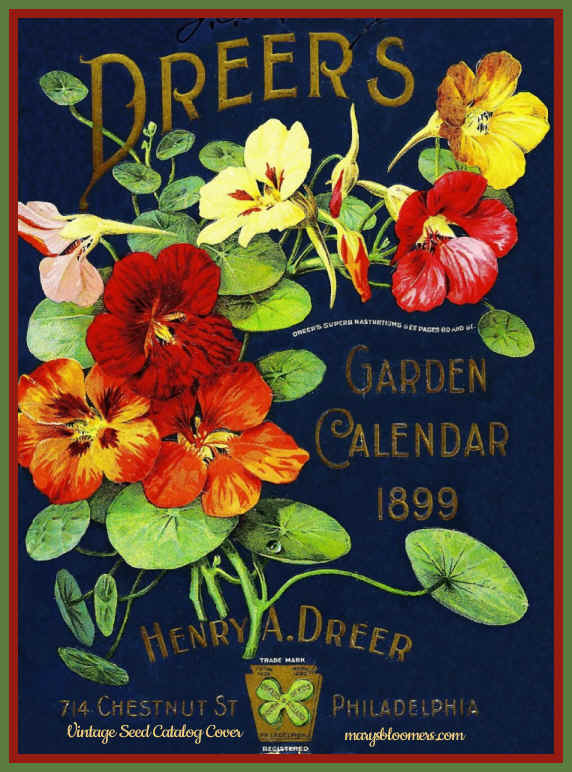 |
A few of the flowers that were popular in these early gardens are rarely seen
or found today.
Mignonette (Reseda odorata), a wonderfully-scented
annual, was grown by many Victorians, though it made no great show. Like a lot
of other old-fashioned plants, it first arrived as an herb. Its name, reseda,
means “calm” and refers to its use as a sedative in Egypt. In France it was
nicknamed “little darling” (mignonette) and was a favorite of
Napoleon’s wife Josephine. Climbing fumitory (Adluma fungosa), an
herbaceous biennial native from Minnesota to Maine, is now on the
“threatened” plant list and is difficult to find.
Some of the common and familiar names are
unfamiliar now. Red celosias were
called “crimson woolflowers”; Lilium candidum was known as
“annunciation lily” because it was often included in paintings of the
Annunciation of Mary. “Heartsease” was the tricolor viola, “piny” was a
peony. Yellow primroses were
called “cowslips,” because they were often found in fields where
cattle grazed. “Peter’s Wreath” was a reference to
any of the spireas.
“Bouncing Bet” or soapwort (Saponaria officinalis) was once
essential to the washerwoman for the lathery liquid made from boiling the
leaves. It has a pretty pink flower in late summer. Because of its
rapid growing habit (it’s invasive), it has lost favor among gardeners today.
I say grow the invasives in pots to confine and enjoy them, and keep
them dead-headed... cut off the spent blooms so seed doesn't escape and
sprout. Also very rarely grown now, feverfew (Chrysanthemum parthenium) has
been known as a medicine since medieval times. As its name suggests, it was
generally used to treat headaches and fevers. Its habit of seeding everywhere is
probably the reason today’s gardeners don’t plant it. It's a very pretty and
clean-looking flower. And herbalists do grow it. It's found on the
natural supplements shelves in stores everywhere as caps and liquids.
Chamomile is also a must-have in a cottage or herbalist's
garden. We all know the research about it concerning it's
calming abilities and help with insomnia. And it's very pretty. I always
mistake them for daisies.
Besides the flowers, there were listings of old-fashioned herbs for kitchen
and medicinal gardens. These included wormwood (Artemisia absintheum),
southernwood (Artemisis abromatum), hyssop (Hyssop officinalis),
rue, (Ruta graveolens), and sorrel (Rumex crispus), as well as
mints and lavender.
Many seed and plant nurseries offered hardy vines
- wisteria, clematis, honeysuckle (Loniceria
japonica) and jasmine or annual ones — morning glory (Ipomoea)
or moon flower (Calonyction). Every porch, fence, arbor and clothesline pole
was decorated with colorful climbers.
Seedsmen also recommended flowering shrubs, like the cascading bridal wreath (Spirea
prunifolia), Japanese snowball (Viburnum plicatum), snowberry (Symphoricarpus
albus) with its pure white berries, mock orange (Philadelphus
coronarius) and, of course the fragrant spring bloomer, the lilac.
To begin your garden, draw out a
plan, make it an informal garden design with a focal point like lilac,
rose of sharon, or any tall shrub. Choose flowers that live in your
memory of Grandmother's Garden, or create your own memory to pass along. Free
design plans are available on this page, and you're sure to
find one in any size and shape to design your rendition of Grandmother's
Garden. Plans have suggested plants listed, but you can use the
heirlooms listed on this page as substitutes.
|
